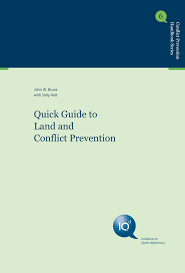Resource information
This Quick Guide to Land and Conflict Prevention presents approaches and alternatives for addressing tensions over land, resources and property which left unaddressed may lead to violent conflict. Historical grievances and competing claims to access rights, tenure insecurity and unequal distribution of land are common causes of such tension. Current trends in population growth, climate change, environmental degradation, resettlement, and land use patterns, including large scale acquisitions, create a very real and rapidly growing potential for conflict. Effective management of these and related dynamics is essential as demands multiply, resources diminish and competition increases. Presented in an easy to use format, this Quick Guide provides step-by-step guidance for conflict prevention actors working to prevent destructive violence in finding the space for policy, law, and institutional reforms in the land sector, and promoting just and workable solutions that are in line with international standards and effective practices. It sets out process-oriented measures which can help manage conflict and buy valuable time, as well as options for substantive responses that are crucial to address the underlying fundamental needs and grievances which can lead to conflict.


